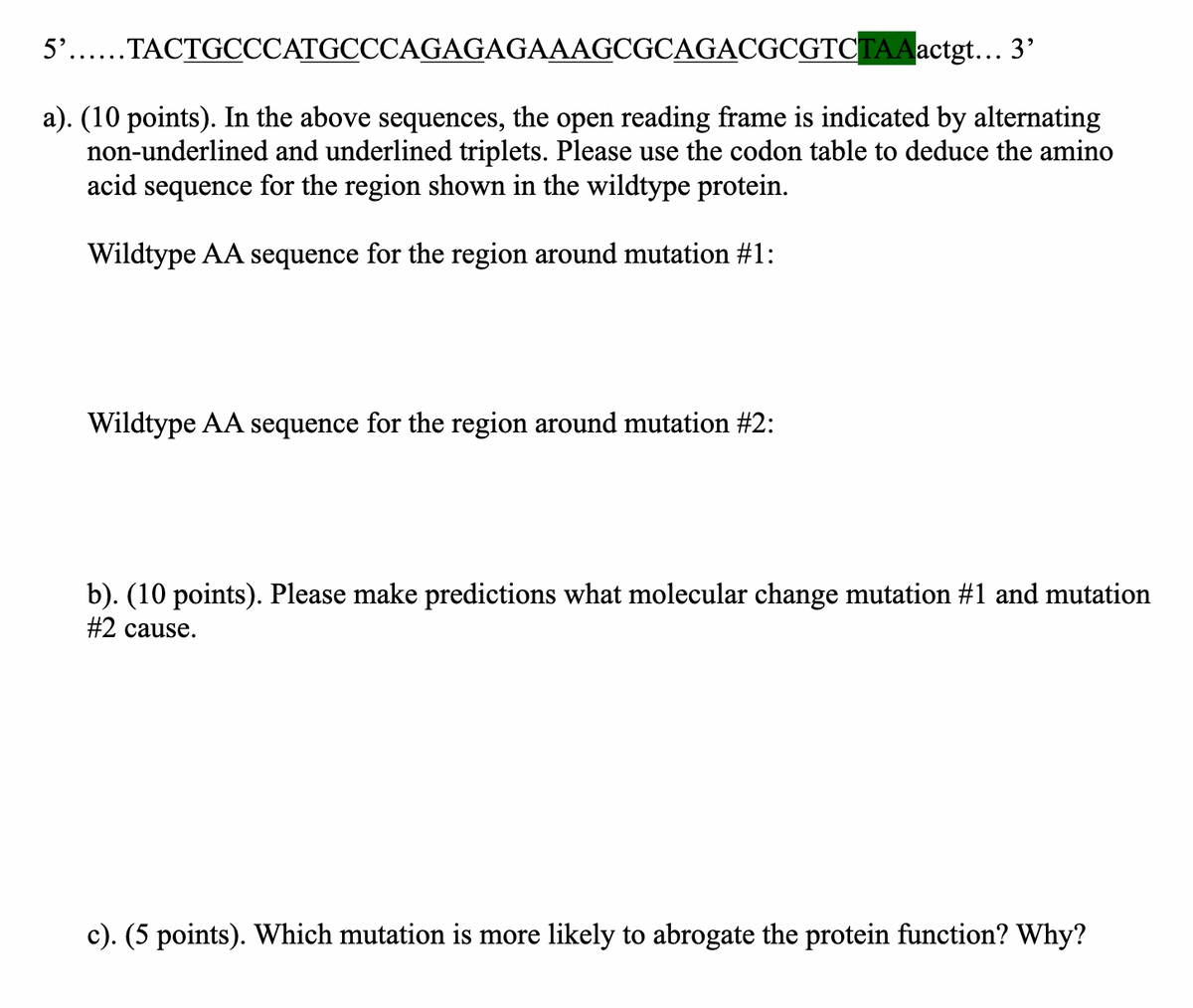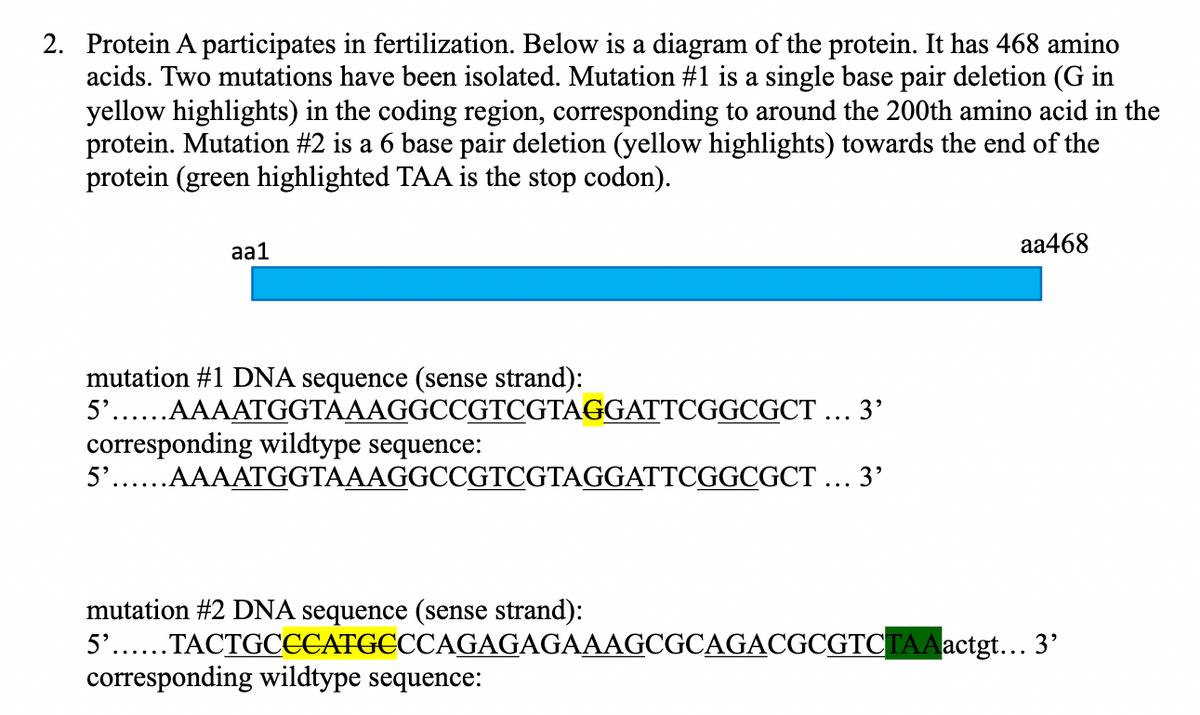5'....TACTGCCCATGCCCAGAGAGAAAGCGCAGACGCGTCTAA actgt... 3' a). (10 points). In the above sequences, the open reading frame is indicated by alternating non-underlined and underlined triplets. Please use the codon table to deduce the amino acid sequence for the region shown in the wildtype protein. Wildtype AA sequence for the region around mutation #1: Wildtype AA sequence for the region around mutation #2: b). (10 points). Please make predictions what molecular change mutation #1 and mutation #2 cause. c). (5 points). Which mutation is more likely to abrogate the protein function? Why? 2. Protein A participates in fertilization. Below is a diagram of the protein. It has 468 amino acids. Two mutations have been isolated. Mutation #1 is a single base pair deletion (G in yellow highlights) in the coding region, corresponding to around the 200th amino acid in the protein. Mutation #2 is a 6 base pair deletion (yellow highlights) towards the end of the protein (green highlighted TAA is the stop codon). aa1 aa468 mutation #1 DNA sequence (sense strand): 5'......AAAATGGTAAAGGCCGTCGTAGGATTCGGCGCT ... 3' corresponding wildtype sequence: 5'...AAAATGGTAAAGGCCGTCGTAGGATTCGGCGCT ... 3' mutation #2 DNA sequence (sense strand): 5'......TACTGCCCATGCCCAGAGAGAAAGCGCAGACGCGTCTAA actgt... 3' corresponding wildtype sequence:
5'....TACTGCCCATGCCCAGAGAGAAAGCGCAGACGCGTCTAA actgt... 3' a). (10 points). In the above sequences, the open reading frame is indicated by alternating non-underlined and underlined triplets. Please use the codon table to deduce the amino acid sequence for the region shown in the wildtype protein. Wildtype AA sequence for the region around mutation #1: Wildtype AA sequence for the region around mutation #2: b). (10 points). Please make predictions what molecular change mutation #1 and mutation #2 cause. c). (5 points). Which mutation is more likely to abrogate the protein function? Why? 2. Protein A participates in fertilization. Below is a diagram of the protein. It has 468 amino acids. Two mutations have been isolated. Mutation #1 is a single base pair deletion (G in yellow highlights) in the coding region, corresponding to around the 200th amino acid in the protein. Mutation #2 is a 6 base pair deletion (yellow highlights) towards the end of the protein (green highlighted TAA is the stop codon). aa1 aa468 mutation #1 DNA sequence (sense strand): 5'......AAAATGGTAAAGGCCGTCGTAGGATTCGGCGCT ... 3' corresponding wildtype sequence: 5'...AAAATGGTAAAGGCCGTCGTAGGATTCGGCGCT ... 3' mutation #2 DNA sequence (sense strand): 5'......TACTGCCCATGCCCAGAGAGAAAGCGCAGACGCGTCTAA actgt... 3' corresponding wildtype sequence:
Biology (MindTap Course List)
11th Edition
ISBN:9781337392938
Author:Eldra Solomon, Charles Martin, Diana W. Martin, Linda R. Berg
Publisher:Eldra Solomon, Charles Martin, Diana W. Martin, Linda R. Berg
Chapter13: Gene Expression
Section: Chapter Questions
Problem 12TYU
Related questions
Question

Transcribed Image Text:5'....TACTGCCCATGCCCAGAGAGAAAGCGCAGACGCGTCTAA actgt... 3'
a). (10 points). In the above sequences, the open reading frame is indicated by alternating
non-underlined and underlined triplets. Please use the codon table to deduce the amino
acid sequence for the region shown in the wildtype protein.
Wildtype AA sequence for the region around mutation #1:
Wildtype AA sequence for the region around mutation #2:
b). (10 points). Please make predictions what molecular change mutation #1 and mutation
#2 cause.
c). (5 points). Which mutation is more likely to abrogate the protein function? Why?

Transcribed Image Text:2. Protein A participates in fertilization. Below is a diagram of the protein. It has 468 amino
acids. Two mutations have been isolated. Mutation #1 is a single base pair deletion (G in
yellow highlights) in the coding region, corresponding to around the 200th amino acid in the
protein. Mutation #2 is a 6 base pair deletion (yellow highlights) towards the end of the
protein (green highlighted TAA is the stop codon).
aa1
aa468
mutation #1 DNA sequence (sense strand):
5'......AAAATGGTAAAGGCCGTCGTAGGATTCGGCGCT ... 3'
corresponding wildtype sequence:
5'...AAAATGGTAAAGGCCGTCGTAGGATTCGGCGCT ... 3'
mutation #2 DNA sequence (sense strand):
5'......TACTGCCCATGCCCAGAGAGAAAGCGCAGACGCGTCTAA actgt... 3'
corresponding wildtype sequence:
Expert Solution
This question has been solved!
Explore an expertly crafted, step-by-step solution for a thorough understanding of key concepts.
Step by step
Solved in 2 steps

Recommended textbooks for you

Biology (MindTap Course List)
Biology
ISBN:
9781337392938
Author:
Eldra Solomon, Charles Martin, Diana W. Martin, Linda R. Berg
Publisher:
Cengage Learning

Biology: The Dynamic Science (MindTap Course List)
Biology
ISBN:
9781305389892
Author:
Peter J. Russell, Paul E. Hertz, Beverly McMillan
Publisher:
Cengage Learning

Biology (MindTap Course List)
Biology
ISBN:
9781337392938
Author:
Eldra Solomon, Charles Martin, Diana W. Martin, Linda R. Berg
Publisher:
Cengage Learning

Biology: The Dynamic Science (MindTap Course List)
Biology
ISBN:
9781305389892
Author:
Peter J. Russell, Paul E. Hertz, Beverly McMillan
Publisher:
Cengage Learning